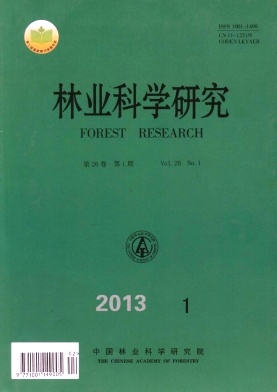Study on the Nutrient Cycling of Ⅰ-69 Poplar Plantation
-
1.
Research Institute of Forestry, Chinese Academy of Forestry, Beijing 100091, China
-
2.
Forestry Institute of Hanshou County, Hanshou 415900, Hunan, China
-
Received Date:
2012-08-20
-
Abstract
The results of positioning test on the nutrient cycling of I-69 poplar plantation within the first rotation show that:(1) The suitable range of average annual leaf nutrient values in the fast-growing period are:N(2.98%-3.37%)>Ca(2.26%-2.95%)>K(0.65%-0.73%)>Mg(0.35%-0.46%)>P(0.11%-0.13)%), indicating the Ⅰ-69 is a N- and Ca-favored species. (2) Both the annual and monthly variations of leaf nutrient values in the fast-growing period are extremely significant; the tree growth is regular and the dynamic changes of leaves in nutrient absorption, accumulation, distribution and transfer reflect the characteristics of nutrient cycling in vivo. The sequence of forest biomass allocation is the same for each of the year and follows the order of stem> branch> lateral root> taproot> stem bark> taproot bark, and the biomass of leaves decrease with the increase of forest age; the nutrient allocation in fast-growing period follow the order of lateral roots> branches> stem>stem bark> taproot> taproot bark; in the late stage, the nutrients in branch and stem are higher than in the lateral roots, and that in leaves decrease with the increase of stand age, but the nutrient distribution ratio for leaves is higher than that for stem; The accumulation and distribution of biological nutrient are consistent with the tree growth. (3)The nutrient cycling rates in the forest ecosystems are 0.47 in the early growth stage and 0.28 in the late growth stage, and the nutrient utilization rates are also different, i.e. in early stage, N 7.6 kg, Ca 4.97 kg, K 1.89 kg, Mg 0.84 kg, and P 0.26 kg are needed to produce 1 ton of dry matter compared with N 4.3 kg, Ca 6.34 kg, K 1.39 kg, Mg 1.14 kg, and P 0.18 kg in late stage. The mean percentages of annual move away of soil nutrients of post-harvested plantation in soil mean available nutrients are N 36.80%, P 52.8%, and K 19.73%, with a rather higher expenditure. However, there is a high level of soil nutrient supply, so the nutrient cycling between trees and soil in the forest ecosystem is still in virtuous circle with dynamic equilibrium.
-

-
References
|
[1]
|
刘爱琴,范少辉,林开敏,等.不同栽植代数杉木林养分循环的比较研究[J].植物营养与肥料学报,2005,11(2):273-278
|
|
[2]
|
余常斌,罗治建,陈卫文,等.幼龄杨树养分含量及其积累季节变化研究[J].福建林学院学报,2005,25(2):181-186
|
|
[3]
|
杨承栋.论合理保护开发利用中国森林土壤资源[J].世界林业研究, 2011, 24(1):19-27
|
|
[4]
|
王少元.合理施用化学肥料提高杨树生长量的效应及其作用机理[M]//中国主要造林树种土壤质量演化与调控机理.北京:科学技术出版社,2009:408-416
|
|
[5]
|
祝 燕,刘 勇,李国雷,等.氮素营养对长白落叶松移植苗生长及养分状况的影响[J].林业科学, 2011,47(9):168-172
|
|
[6]
|
王延平,王华田,姜岳忠,等.氮磷亏缺条件下杨树幼苗根系分泌芬酸的动态[J].林业科学, 2011,47(11):74-79
|
|
[7]
|
Bowen G D,Nambiar E K S. Nutrition of Platation Forests[M].London:Academic Prees, 1989:53-79 |
|
[8]
|
李贻铨,陈章水.黄淮海及长江中游平原土壤与杨树生长关系的初步研究[J].林业科学,1983,19(1):1-13
|
|
[9]
|
杨世桦,徐清彦. Ⅰ-69杨人工林生长规律与营养特性的研究[J].林业科学研究,1991,4(1):38-43
|
|
[10]
|
张 颖,孙向阳,曲天竹,等.三倍体毛白杨不同无性系叶片养分含量研究[J].西北林学院学报, 2008,23(2):64-68
|
|
[11]
|
王保平,李素艳,孙向阳,等.泡桐生长季节中叶片养分吸收变化规律的研究[J]. 林业科学研究, 2005,18(2):120-124
|
|
[12]
|
项文化,田大伦,闫文德,等.第2代杉木林速生阶段营养元素的空间分布特征和生物循环[J].林业科学, 2002,38(2):2-8
|
|
[13]
|
秦武明,何 斌,覃世赢,等.厚荚相思人工林营养元素生物循环的研究[J].林业科学,2007,21(4):103-107
|
|
[14]
|
何 斌,秦武明,余浩光,等.不同年龄阶段马占相思人工林营养元素的生物循环[J].生态学报,2007,27(12):5158-5167
|
|
[15]
|
李淑仪,钟继洪,漠晓勇,等.桉树土壤与营养研究[M].广东科技出版社,2007
|
-
-
Proportional views

-





 DownLoad:
DownLoad: